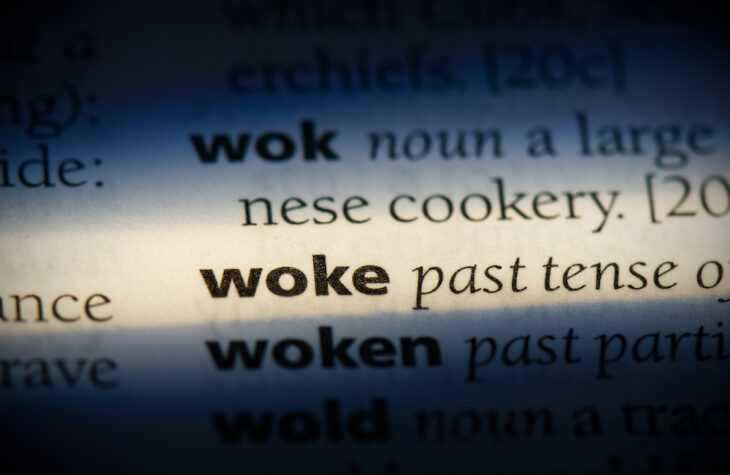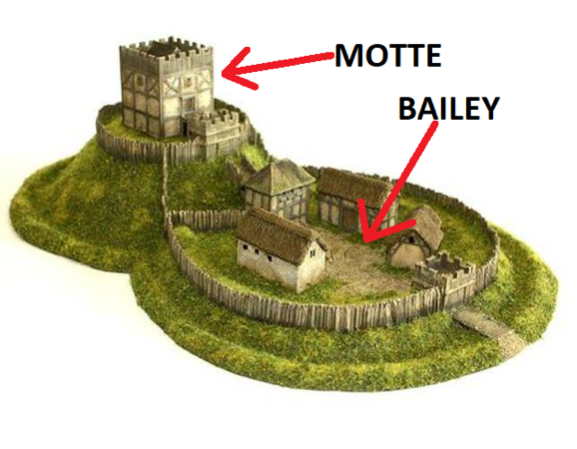
Motte and Bailey: Dishonest Postmodernist Strategy
Many Christians have wondered how it is that postmodern philosophy, with all the nihilism and relativism it requires, has managed to find a home in Christian communities and churches in particular. Traditional Americans, no matter their religious stances, might also wonder how it has ascended to the commanding heights of all our institutions – school systems, corporate boardrooms, academia, and Hollywood – across the whole, it seems, of western society. The answer is largely due to a rhetorical tactic known as the “motte and bailey.” The original postmodernists, and their iterative followers, Critical Social Justice warriors (often called the “woke”), have used the motte and bailey tactic to great effect.
Summary The “Motte and Bailey” Tactic
Professor Nicholas Shackel of Cardiff University coined the motte and bailey analogy almost two decades ago to describe a particular strategy used by postmodern thinkers to spread their ideas.. The phrase is a reference to a medieval structure – a motte – built on high ground above a lower – fenced bailey (see nearby depiction). The bailey is valuable precisely because of the feature that makes it most vulnerable. It is large enough to sustain significant agricultural yields and to facilitate commercial and social activity, but that also makes it difficult to defend. The motte, a small fortress built on high ground adjacent to the bailey, resolves this difficulty. When raiders attack the bailey, its defenders retreat to the motte and rain down arrows on the raiders until they give up and go away. Once they have left, the group can leave the motte and go back to the bailey to harvest the benefits of their rich land.

Understand, the motte’s value is instrumental and subordinate to the actual thing the postmodernist values, a sustained and flourishing life in the bailey below. The motte only exists and is used as long as it takes to repel the enemy from the bailey. Postmodernist academics and activists have become experts in deploying this tactic. They make exciting, bold, controversial, audacious claims (the bailey) from which they retreat promptly to boring, non-controversial, simple claims (the motte) when they are challenged. The postmodernist’s “bailey propositions”, alone indefensible, are the thing of real value, it’s where they live. Meanwhile, the boring, non-controversial, obvious “motte claims” are easy-to-defend and are only retreated to when there is an attack (challenge to) on the bailey claims.
The goal is to keep the bailey a viable place for a flourishing life, and the tactic is used to perpetuate the bailey claims. This rhetorical tactic has been used to great effect for decades, ripening for harvest the “Great Awokening” of the last several years.
Motte and Bailey to Deny God and Reason
Nicholas Shackel is rightly credited as being the first to use the motte and bailey as an analogy for how postmodernists argue,[1] but he is not the first person to notice this sort of strategy being employed by postmodern thinkers. Writing a decade earlier in an essay titled “Literary Theory and Its Discontents,” John Searle recognized this move at work in the writing of the father of postmodern deconstruction: Jacques Derrida. In his early replies to Derrida, Searle said “Derrida has a distressing penchant for saying things which are obviously false.”[2] In “Literary Theory and Its Discontents,” Searle would describe what eventually became known as the motte and bailey strategy:
”In deconstructionist writing in general and Derrida in particular, the intellectual limitations of the background knowledge do not prevent a certain straining of the prose, an urge to achieve a rhetorical effect that might be described as the move from the exciting to the banal and back again. The way it works is this: Derrida advances some astounding thesis, for example, writing came before speaking, nothing exists outside of texts, meanings are undecidable. When challenged, he says, “You have misunderstood me, I only meant such and such,” where such and such is some well-known platitude. Then, when the platitude is acknowledged, he assumes that its acknowledgement constitutes an acceptance of the original exciting thesis.”[3]
This approach in the hands of postmodernists like John Caputo, a well known philosopher from Villanova University, has proven remarkably effective in smuggling postmodern propositions into Christian teaching. In arguing for deconstruction, Caputo claims:
“If the truth can make us free, as we all so readily agree, it cannot do so without a deconstruction, which is a way of making, or letting, the truth happen.”
“[D]econstruction provides a felicitous hermeneutic of the kingdom of God.”
This is Caputo’s motte. If we all “readily agree” that the truth can make us free, and if deconstruction is just a way of “making, or letting, the truth happen,” then all is well, we are all on the ground of “truth” and agree that “truth” is the goal. Most sincere Christians are now disarmed, after all they know and agree that “the truth will set you free” (John 8:32). So disarmed, they may readily now agree that “deconstruction” essential as it is to the “truth” is a “felicitous [well suited] hermeneutic [way of interpreting] of the Kingdom of God,” what is there to argue with? If deconstruction just helps us discover the truth, ultimately the truth about the Kingdom of God, then why should Christians object?
All this serves to distract from Caputo’s real project:
“Deconstruction protests the dangerous illusions of pure reason and pure logic which lull us to sleep about the real interests by which reason is always subverted.”
Now we have found the bailey, the exciting proposition that is utterly indefensible: that reason and logic are always undermined by human interests, and that deconstruction is what “protests” or works against that undermining. Caputo’s doctrine of deconstruction includes the claim that reason is always subverted or overtaken by interests. However, if reason is always subverted by interests, then the reason by which Caputo reaches his own conclusions must also have been subject to the same thing Caputo says subverts all reason: human interest; in this case John Caputo’s interests. If we accept Caputo’s argument, then his conclusions are no more valid than any other conclusion reached by anyone else. Caputo cuts off the branch on which he sits, undercutting his own argument.
Note that the controversial claim is Caputo’s bailey, that deconstruction protests against these subverting interests, is a very different claim than his motte which says “deconstruction lets truth happen.” Caputo advances a controversial claim – an assault on reason – ready to retreat to a less controversial claim (that deconstruction is letting truth happen) when challenged. Once the challengers have relented, Caputo’s assault on reason can continue.
Caputo’s entire project, compelling as it has seemed to so many Christians, relies in large part on the same trick. He constructs another motte and bailey around his claims about truth (emphasis added):
”I do not recommend ignorance and I am not saying that there is no truth, but I am arguing that the best way to think about truth is to call it the best interpretation that anybody has come up with yet while conceding that no one knows what is coming next.”
This passage begins with Caputo denying that he thinks that “there is no truth” but proceeds to Caputo’s redefinition of truth to refer to “the best interpretation anybody has yet. By redefining truth as “the best interpretation anybody has yet” Caputo has removed objectivity from his definition of truth. On this redefinition of truth all we have is the “the best interpretation anybody has yet,” and interpretations are necessarily subjective. With the motte in place, Caputo harvests in his bailey:
“That is the cold, hermeneutic truth, the truth that there is no truth, no master name which holds things captive.”
“The truth is that there is no truth, and she, being herself a creature of fiction, device, art, artifice, illusion, and ornamentation, cannot be fooled at her own game, fooled into believing that she herself has an essence and truth.”
“The truth of Being would then be that there is no truth, no privileged sense of Being, and hence no privileged epoch either.”
Caputo’s bailey is an explicit denial of the existence of truth. This read of his project, uncharitable though it may seem, is hardly novel. William Lane Craig interpreted Caputo exactly the same way while providing a beautiful refutation of Caputo:
“‘The truth’ as John Caputo says, ‘is that there is no truth.’ But such a claim falls prey to precisely the same objections that I raised above. Indeed, the postmodernist claim is not really distinguishable from certain Buddhist philosophies. To assert that ‘the truth is that there is no truth’ is both self-refuting and arbitrary. For if this statement is true, it is not true, since there is no truth. So-called deconstructionism thus cannot be halted from deconstructing itself.”[4]
It is exactly this sort of refutation that necessitates the creation of Caputo’s motte. When Craig refutes Caputo’s claims about truth, Caputo can retreat to his motte and claim he is not really denying that truth exists, but merely discussing how our various interpretations change and no one knows what is next. When Craig’s refutation is out of view, Caputo can go back claiming there is no truth. Caputo’s denials do not stop at “truth” itself but extend to the the classical doctrine of omnipotence and the existence of God:
“The classical doctrine of omnipotence effectively ruins the deconstructive idea of the impossible and also of God for Derrida and that is why I wrote a book against it.”
“I am not arguing (and do not think) that there is a being called God somewhere who does or fails to do impossible things. Nor do I argue or think that God is the Being of beings, or a hyper-Being beyond Being in the tradition of mystical theology, or the ‘God without Being’ of Jean-Luc Marion”
Yet, by using the motte and bailey strategy, Caputo succeeds in exercising tremendous influence in Christian intellectual circles even though he denies God’s omniscience, and even God’s existence. Who needs atheists with Christians like John D. Caputo?
Motte and Bailey to Attack Epistemology
Postmodernists also employ the motte and bailey to make radical claims about epistemology – how we know what we know. “Standpoint epistemology” claims that one’s capacity for knowledge is a product of one’s social position. The idea is that specific characteristics – whether one is black or white, gay or straight, trans or not, disabled or not, along with one’s class – all determine, at least in part, what one is able to know. Sandra Harding, a founder of this perspective, claims:
“I shall show why it is reasonable to think that the socially situated grounds and subjects of standpoint epistemologies require and generate stronger standards for objectivity than do those that turn away from providing systematic methods for locating knowledge in history.”[5]
“Stronger standards for objectivity” here serves as the motte; any truth seeker ought to embrace stronger standards for objectivity. Yet, as with all postmodern motte and bailey arguments, the bailey reveals the radicalism of the claim she actually means to defend:
“The adequacy of standpoint projects is to be judged by the success of the practices they legitimate rather than the truth or verisimilitude of representations of nature and social relations. (Recollect that the success of practices has always been the ultimate test of the adequacy of certain claims.) Do they in fact produce more accurate, comprehensive, rationally justifiable, and politically useful knowledge for the exploited group to which they are accountable?”
As one might imagine, the idea that one should decide what counts as knowledge on the basis of what is politically useful to a particular group is not a defensible claim. However, by creating this motte and bailey, Harding can advocate for using political usefulness as a standard for knowledge, and retreat to the claim that she wants “strong objectivity” when she is challenged.
Stunningly, Harding explicitly admits to using the language of “strong objectivity” for purely cynical reasons:
“So, I’m simply using the rhetoric of objectivity because it’s an incredibly powerful language. It’s a calculated attempt to make it progressive because (let me not sound too cynical here) my point is that notions such as objectivity are deeply embedded in the institutions of the West that we’re proudest of-the legal tradition for example.”
Sometimes the mask slips, and sometimes postmodernists take it off on their own.
Motte and Bailey: The Rhetorical Architecture of a Smear
In addressing the charge that his postmodern project would lead to relativism and immorality, Richard Rorty responded not with an argument but with a rhetorical strategy(emphasis mine):
“So my strategy will be to try to make the vocabulary in which these objections are phrased look bad, thereby changing the subject, rather than granting the objector his choice of weapons and terrain by meeting his criticisms head on.”
Rather than arguing against the idea on rational grounds, or offering some justification for using better vocabulary, Rorty – one of postmodernism’s foremost intellectual lights – has adopted the position of the political operative: try to make the objector look bad and then change the subject.
John Caputo has adopted that very same tactic. In the context of a discussion about the Augustinian view that there is a world within space and time, and a world which transcends space and time, he appeals to Rorty’s advice (emphasis mine):
“I concede that there’s no stopping someone from holding an Augustinian two worlds view, the way you cannot stop someone from believing in guardian angels, demonic possession or alien abductions. All you can do, as Rorty said, is try to discourage it by making it look bad and by offering a more persuasive alternative, in this case, a way of reimagining God and reinventing Christianity . . . .”
“Woke” social justice activists have taken their cues from Rorty and Caputo. seThey try to make their opponents “look bad” by smearing them with labels like “racist,” “white supremacist,” and “sexist,” in order to further their own ends without defending their merits. Rather than making their case, they redefine the terms of debate, allowing them to label their opponents as “white supremacists” or “racists” while denying that they have done anything out of order.
Christian postmodernists, in turn, have embraced these activist smear techniques.
Last year Duke Kwon and Dr. Gregory Thompson wrote a response to Kevin DeYoung’s review of their recent book. Rather than addressing the merits, Kwon and Thompson smear DeYoung by associating him with white supremacy. DeYoung, they admit, “neither sees it nor intends it”’ but nonetheless “centers whiteness at every turn. Like King’s opponents in 1963, he consistently privileges white theological voices, minimizes white supremacy’s tragic impact on the lives of ‘non-white’ persons, and prioritizes the comfort of white people. And in this respect, while he does not argue for white supremacy, he nevertheless performs its most basic impulses.”[6]
DeYoung, they allow, may have no sympathy to white supremacy, but he is “heir to and practitioner of a mode of theological reasoning” that has “sustain[ed] the project of white supremacy.” They further claim that Deyoung’s “choice to relativize white guilt and to prioritize white forgiveness consummates his performance of white supremacy by embodying its essence.”
This indeed makes Kevin DeYoung look very bad, even as the substance of his arguments remains entirely unaddressed.
On Twitter, Kwon defines white supremacy in terms intended to facilitate similar motte and bailey techniques against all challengers :
“We can speak of 3 dimensions of white supremacy:”
#1. WS is an IDEOLOGY centered on the belief that the white race is superior to, and therefore entitled to dominance over, non-white races.
#2. WS is a social MOVEMENT comprised of individuals/groups whose explicit aim is to promote/establish white dominance in society.
#3. WS is a SYSTEM of beliefs, laws, practices, customs, and norms that confers social advantage to whiteness by exploiting non-whiteness.
(#3. cont.) It’s the structuring of society around establishing/protecting white privilege/normativity—with/without conscious racial hatred.”
In their essay Kwon and Thompson state that the way that they are using the term is in reference to the 3rd “structural” definition. This is the motte. The bailey is the other definitions in play. Definitions #1 and #2 describe the way that most people think of white supremacy. Namely: “the belief that the white race is superior to, and therefore entitled to dominance over, non-white races” and “individuals/groups whose explicit aim is to promote/establish white dominance in society.” These are beliefs that everyone, including DeYoung, rightly deplores, and it is this understanding of white supremacy that gives the term “white supremacy” its linguistic bite. The reason that people recoil in horror at being associated with white supremacy is exactly because most people associate the term with conscious and intentional racial bigotry. The power of the term white supremacy, the reason it is a morally and emotionally supercharged term, is because it is associated with conscious, intentional racial bigotry.
However, Kwon and Thompson state in their piece that they are using the term “white supremacy” in a technical sense to refer to structural issues not that of conscious, intentional racial bigotry:
“[W]hite supremacy is not, in fact, about ideas (although it certainly entails these). Nor is it primarily about the beliefs and practices of individuals (although it entails these too). It is—as we state repeatedly—primarily about a comprehensive system of cultural structures, and the demonstrable effects of those structures on the lives of African Americans.”[7]
But Kwon and Thompson know well that the linguistic bite of the term “white supremacy” comes from the term’s association with the intentional bigorty from the likes of the Nazis and the Ku Klux Klan. That association is what provides rhetorical force to their smear of DeYoung.
This is a rhetorical motte and bailey. Kwon and Thompson can spray Kevin DeYoung with the stink of white supremacy owing to the term’s rhetorical force, and when challenged they can retreat to the motte of the “structural” definition of white supremacy and claim they never called Deyoung a bigot.
Having used a motte and bailey to spray DeYoung with the stench of white supremacy, Kwon and Thompson then make the move to claim that DeYoung’s attempts to engage on theological grounds are actually “expressive of a cultural project that seeks perennially to justify itself on theological grounds.” By their own admission DeYoung attempted to engage on the ground of theology. However, rather than engage on that ground, they proceeded to argue against him on the ground of culture.
Recall Rorty, make them look bad, change the subject, get on my ground where I have the advantage.[8]
Kwon and Thompson do exactly that. They make DeYoung look bad by changing the topic from theology to culture, then using a motte and bailey to spray DeYoung with the social stink of white supremacy.
Strategic Relativism
Postmodernists appealing to Christians have employed the motte and bailey well. Caputo denies objective reason. Sandra Harding substitutes political utility for truth. Kwon and Thompson smear Christian critique by association to the “cultural project of white supremacy.”
This latter strategy – making opponents look bad – can be redeployed to similar effect against postmodernists themselves. Notes Shackel:
“I am happy to speak to postmodernists in their own terms. A good rhetorical trouncing of postmodernism, however sophistical [unsound and misleading], is something a postmodernist should be persuaded by. Indeed, in the face of such a trouncing they would then be impaled on the horns of a dilemma: If they reject it for being sophistry they acknowledge that their position is ill founded, for such complaints can only be made from a prior acceptance of precisely the robust rationality which it is my wider purpose to defend from their skepticism. If they accept it, its conclusion is that postmodernism should be renounced. Either way, they reject postmodernism”
Conclusion
Postmodernists have been able to use the motte and bailey to launder their ideology into both the church and the larger culture. They have defamed their most eloquent opponents by smearing them with charged labels like “racist,” “white supremacist,” “sexist,” and “misogynist,” each redefined sufficiently for them to claim that they are just using technical language. Christians should recognize the significance of such deceptive rhetoric. In exposing it, they may be better able to defeat postmodern arguments with the same vigor with which the postmodernists have employed their mottes and baileys.
For example, one effective tactic is to focus directly on the bailey. In the case of John Caputo, highlight his denial of truth, his denial of the classical doctrine of God’s omnipotence, and his denial that any such being as God exists. Every time he retreats to his motte highlight the fact that he is retreating to a motte. Then ask if he is admitting that his claims are wrong? Post modernists must be brought down from the motte, by focusing and focusing again on the bailey. Every time he retreats to one of his mottes, point out that he is retreating to a less controversial position, and force him back to defending the bailey. This way of answering Caputo, does two things:
- It makes the fact that he is dodging the question by retreating to his motte very obvious, so people don’t get fooled by it.
- It forces him to defend the controversial claims in his bailey rather than getting to defend the less controversial claims in his motte.
To defeat the motte and bailey, force the person using the motte to defend the bailey.
Footnotes
1. John D Caputo What would JEsus Deconstruct: The Good News of Postmodernity for the Church. (Baker Academic, 2007) p.29
2. John D Caputo What would JEsus Deconstruct: The Good News of Postmodernity for the Church. (Baker Academic, 2007) p.33
3. John D. Caputo, Radical Hermeneutics: Repetition, Deconstruction, and the Hermeneutic Project. (Indiana University Press. 1987) p.234
4. Throughout this piece, all emphasis as indicated by bolding and italics are my own.
5. John D. Caputo, On Religion, (Second edition published 2019, by Routledge, an imprint of Taylor and Francis) p.22
6. John D. Caputo, Radical Hermeneutics: Repetition, Deconstruction, and the Hermeneutic Project. (Indiana University Press. 1987) p.192
7. John D. Caputo, Radical Hermeneutics: Repetition, Deconstruction, and the Hermeneutic Project. (Indiana University Press. 1987) P.156 {For this passage Caputo cites Jaques Derrida, but he does not QUOTE Derrida here. The citation is Jaqcues Derrida, Spurs: Neitzche’s Styles, (The University of Chicago Press. 1979)
8. John D. Caputo, Radical Hermeneutics: Repetition, Deconstruction, and the Hermeneutic Project. (Indiana University Press. 1987) p.181
9. Caputo, antireligion P.37
10. John D. Caputo, “The Return of Anti-Religion: From Radical Atheism to Radical Theology,” Journal of Cultural and Religious Theory, Vol. 11, No.2 (Spring 2011), 37
11. Sandra Harding, “Standpoint Theories: Productively Controversial.” Hypatia 24, no. 4 (2009): 192–200. P.195
12. Starting from Marginalized Lives: A Conversation with Sandra Harding Author(s): Elizabeth Hirsh, Gary A. Olson and Sandra Harding Source: JAC , 1995, Vol. 15, No. 2 (1995), P.215
13. Richard Rorty, Contingency, Irony, Solidarity (Cambridge University Press, 1989) P. 44
14. John D. Caputo, “The Return of Anti-Religion: From Radical Atheism to Radical Theology,” Journal of Cultural and Religious Theory, Vol. 11, No.2 (Spring 2011), 119-120
15. The first tweet in the thread is here: https://twitter.com/dukekwondc/status/801174113406611456
16. Nicholas Shackel “The Vacuity of Postmodern Methodology” Metaphilosophy. Vol. 36 April 2005 pps. 296




